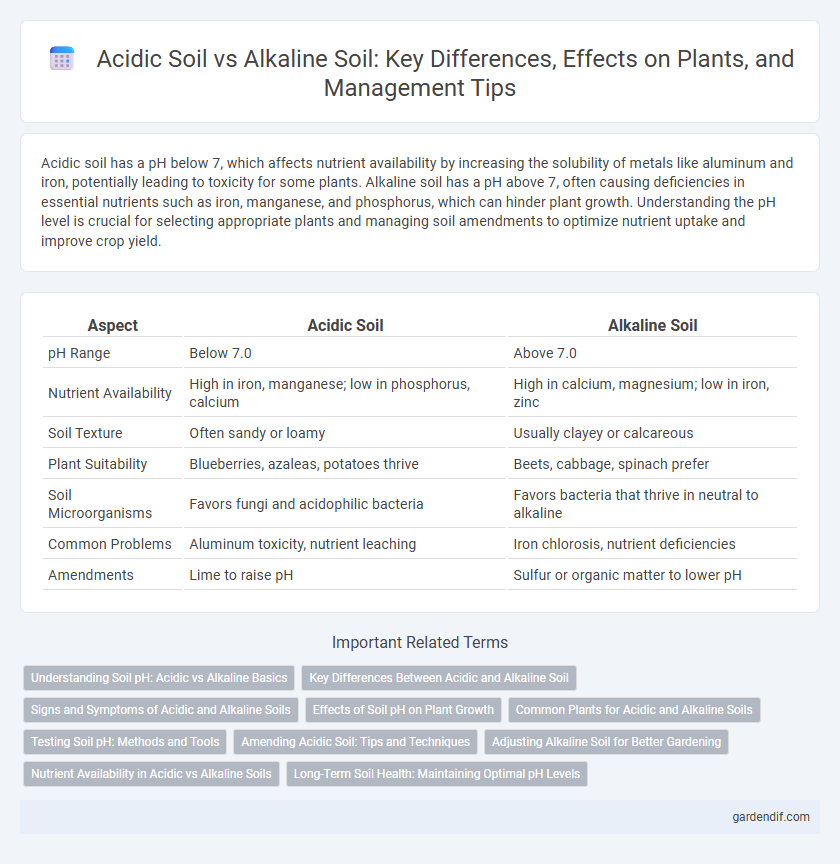
Acidic Soil vs Alkaline Soil Illustration
Acidic soil has a pH below 7, which affects nutrient availability by increasing the solubility of metals like aluminum and iron, potentially leading to toxicity for some plants. Alkaline soil has a pH above 7, often causing deficiencies in essential nutrients such as iron, manganese, and phosphorus, which can hinder plant growth. Understanding the pH level is crucial for selecting appropriate plants and managing soil amendments to optimize nutrient uptake and improve crop yield.
Table of Comparison
| Aspect | Acidic Soil | Alkaline Soil |
|---|---|---|
| pH Range | Below 7.0 | Above 7.0 |
| Nutrient Availability | High in iron, manganese; low in phosphorus, calcium | High in calcium, magnesium; low in iron, zinc |
| Soil Texture | Often sandy or loamy | Usually clayey or calcareous |
| Plant Suitability | Blueberries, azaleas, potatoes thrive | Beets, cabbage, spinach prefer |
| Soil Microorganisms | Favors fungi and acidophilic bacteria | Favors bacteria that thrive in neutral to alkaline |
| Common Problems | Aluminum toxicity, nutrient leaching | Iron chlorosis, nutrient deficiencies |
| Amendments | Lime to raise pH | Sulfur or organic matter to lower pH |
Understanding Soil pH: Acidic vs Alkaline Basics
Soil pH measures the concentration of hydrogen ions, determining whether soil is acidic (pH below 7) or alkaline (pH above 7), which directly influences nutrient availability and microbial activity. Acidic soils commonly contain higher levels of aluminum and iron, limiting the uptake of essential nutrients like phosphorus, calcium, and magnesium, whereas alkaline soils tend to have excess calcium carbonate, sometimes causing nutrient deficiencies such as iron chlorosis. Understanding these pH-related soil characteristics helps optimize plant growth by guiding appropriate amendments like lime for acidic soils or sulfur for alkaline soils.
Key Differences Between Acidic and Alkaline Soil
Acidic soil typically has a pH below 7, favoring plants like blueberries and azaleas that thrive in low pH environments, while alkaline soil has a pH above 7, supporting crops such as spinach and asparagus. Nutrient availability differs significantly; acidic soil often limits calcium, magnesium, and phosphorus, whereas alkaline soil can restrict iron, manganese, and zinc uptake. Soil texture and organic matter content also influence the pH balance, impacting microbial activity and overall plant health in both acidic and alkaline soils.
Signs and Symptoms of Acidic and Alkaline Soils
Acidic soil often exhibits symptoms such as poor plant growth, yellowing leaves due to iron chlorosis, and stunted root development, indicating nutrient deficiencies like calcium and magnesium. Alkaline soil symptoms include chlorosis from iron immobilization, poor phosphorus availability, and browning root tips, signaling an imbalance in essential micronutrients. Both soil types affect plant health by altering nutrient uptake and necessitate soil testing for accurate pH adjustment.
Effects of Soil pH on Plant Growth
Soil pH significantly influences nutrient availability and microbial activity, directly impacting plant growth and development. Acidic soils (pH below 7) often limit essential nutrients like phosphorus, calcium, and magnesium, while increasing toxic metals such as aluminum, which can inhibit root growth. Alkaline soils (pH above 7) reduce the solubility of micronutrients like iron, manganese, and zinc, leading to deficiencies that affect chlorophyll production and overall plant health.
Common Plants for Acidic and Alkaline Soils
Common plants thriving in acidic soils include azaleas, blueberries, and rhododendrons, known for their preference for pH levels below 6. Alkaline soils, with pH values above 7, support species like lilacs, clematis, and lavender that are well-adapted to nutrient availability in higher pH conditions. Understanding the compatibility of plant species with soil pH enhances growth, nutrient uptake, and overall plant health.
Testing Soil pH: Methods and Tools
Testing soil pH involves using tools such as pH meters, litmus paper, and chemical test kits to accurately determine whether soil is acidic or alkaline. Digital pH meters provide precise readings by measuring the hydrogen ion activity directly in soil samples, while colorimetric kits change color based on pH levels and are useful for quick field assessments. Consistent soil pH monitoring helps optimize nutrient availability and plant health by informing appropriate soil amendment strategies.
Amending Acidic Soil: Tips and Techniques
Amending acidic soil involves raising its pH by incorporating lime (calcium carbonate) or wood ash to neutralize excess acidity and improve nutrient availability. Organic matter such as compost or well-rotted manure enhances soil structure and buffering capacity, promoting microbial activity essential for soil health. Regular soil testing guides precise lime application, preventing overcorrection and maintaining optimal pH levels between 6.0 and 7.0 for most plants.
Adjusting Alkaline Soil for Better Gardening
Adjusting alkaline soil for better gardening involves lowering its pH to enhance nutrient availability and promote healthy plant growth. Incorporating elemental sulfur, organic matter like compost, or acidic fertilizers helps neutralize alkalinity and improve soil structure. Regular soil testing ensures precise pH adjustments to maintain optimal conditions for acid-loving plants such as azaleas, blueberries, and hydrangeas.
Nutrient Availability in Acidic vs Alkaline Soils
Nutrient availability in acidic soil typically results in higher solubility of metals like aluminum and manganese, which can become toxic to plants, while essential nutrients such as phosphorus, calcium, and magnesium often become less accessible. In contrast, alkaline soil enhances the availability of calcium, magnesium, and molybdenum but causes deficiencies in iron, manganese, and phosphorus due to precipitation as insoluble compounds. Managing soil pH is crucial for optimizing nutrient uptake and ensuring healthy plant growth.
Long-Term Soil Health: Maintaining Optimal pH Levels
Maintaining optimal pH levels in acidic soil, typically below 6.5, promotes nutrient availability and microbial activity essential for long-term soil health, while alkaline soil above pH 7.5 can limit the absorption of key nutrients like iron and phosphorus, potentially leading to deficiencies. Regular soil testing and amendments such as lime for acidic soils or sulfur for alkaline soils help balance pH, ensuring sustained fertility and crop productivity. Consistent pH management protects soil structure and biological diversity, fostering resilient ecosystems and preventing degradation over time.
Acidic Soil vs Alkaline Soil Infographic

 gardendif.com
gardendif.com